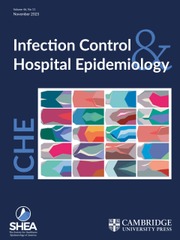Article contents
Physician perceptions of barriers to infection prevention and control in labor and delivery
Published online by Cambridge University Press: 20 November 2023
Abstract
To learn about the perceptions of healthcare personnel (HCP) on the barriers they encounter when performing infection prevention and control (IPC) practices in labor and delivery to help inform future IPC resources tailored to this setting.
Qualitative focus groups.
Labor and delivery units in acute-care settings.
A convenience sample of labor and delivery HCP attending the Infectious Diseases Society for Obstetrics and Gynecology 2022 Annual Meeting.
Two focus groups, each lasting 45 minutes, were conducted by a team from the Centers for Disease Control and Prevention. A standardized script facilitated discussion around performing IPC practices during labor and delivery. Coding was performed by 3 reviewers using an immersion-crystallization technique.
In total, 18 conference attendees participated in the focus groups: 67% obstetrician-gynecologists, 17% infectious disease physicians, 11% medical students, and 6% an obstetric anesthesiologist. Participants described the difficulty of consistently performing IPC practices in this setting because they often respond to emergencies, are an entry point to the hospital, and frequently encounter bodily fluids. They also described that IPC training and education is not specific to labor and delivery, and personal protective equipment is difficult to locate when needed. Participants observed a lack of standardization of IPC protocols in their setting and felt that healthcare for women and pregnant people is not prioritized on a larger scale and within their hospitals.
This study identified barriers to consistently implementing IPC practices in the labor and delivery setting. These barriers should be addressed through targeted interventions and the development of obstetric-specific IPC resources.
- Type
- Original Article
- Information
- Creative Commons
- To the extent this is a work of the US Government, it is not subject to copyright protection within the United States. To the extent this work is subject to copyright outside of the United States, such copyright shall be assigned to The Society for Healthcare Epidemiology of America and licensed to the Publisher. Outside of the United States, the US Government retains a paidup, nonexclusive, irrevocable worldwide license to reproduce, prepare derivative works, distribute copies to the public and display publicly the Contribution, and to permit others to do so. Published by Cambridge University Press on behalf of The Society for Healthcare Epidemiology of America.
- Copyright
- © The Society for Healthcare Epidemiology of America, 2023
References
- 1
- Cited by



